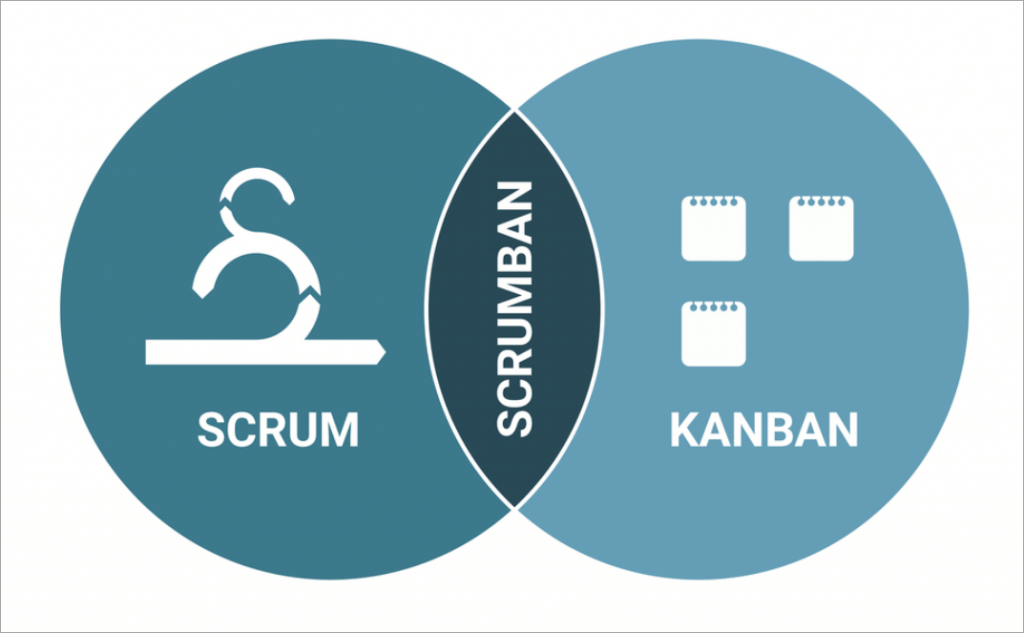In the world of project management, there is constant evolution and transformation of one methodology into another. The combination of traditional and agile methodologies has given rise to the hybrid project management model. In the same way, the Scrumban methodology is a hybrid of two agile project management methodologies of Scrum and Kanban.
While the methodology of Scrum is a well-known agile discipline, the Kanban methodology has its roots in Lean. The Scrumban methodology combines the advantages of Scrum and Kanban to face the challenges organizations face in managing current projects. This methodology is flexible and adaptable. It promotes continuous improvement along with value addition.
Jump ahead to
What is Scrumban?

Scrumban is an agile project management framework that combines the benefits of Scrum and Kanban methodologies. It was initially created as a transitional method for teams using Scrum to transition into Kanban. However, due to some of the significant advantages of the Scrumban methodology, it has since been used as a standalone agile framework.
Before elaborating on the methodology of Scrumban, here is a brief outline of Scrum and Kanban:
Scrum
It is an agile methodology that helps organizations run projects in 1-4 weeks iterations or sprints. Scrum focuses on maximizing the executive team’s capabilities to deliver results quickly, become flexible, and quickly adapt to market changes.
Scrum teams are responsible for breaking the work into small manageable tasks on a priority basis. These teams are small, cross-functional, and self-organizing. Its main objective is to complete the goals the product owner sets within the fixed-length development cycles.
Kanban
It is a Lean approach to delivering projects that focuses on increasing workflow efficiency. Kanban is represented as boards used by organizational teams to visualize the workflow and the progress of the projects.
Teams using Kanban use the Kanban boards to manage the tasks at hand. Here the tasks are depicted by cards, and lanes represent the process steps. The team manages the work through the WIP (work-in-progress) limits tool.
Both Scrum and Kanban have their advantages and disadvantages. The Scrumban methodology combines the advantages of these two disciplines to fulfill the organization’s requirements in delivering projects that are more complex and have multiple levels.
What is the need for Scrumban?
The methodology of Scrumban is best suited for modern projects having multidisciplinary requirements. These current projects are much more complex and require elaborate planning. The Scrumban method helps executive teams deliver projects successfully using Scrum’s structure and Kanban’s flexibility. It uses the best features of both disciplines to meet the organization’s and its stakeholders’ requirements.
How does Scrumban combine Scrum and Kanban?
As we know from the above sections, Scrumban combines the best Scrum and Kanban methodology elements. This helps organizations deliver projects according to the requirements of the market or the stakeholders.
Here are some of the best features of Scrum that are incorporated into the Scrumban methodology:
- Planning and reviewing the work
- Determining the complexity of the work and the length of the iteration
- Deciding how much work can be done within fixed-length development cycles
- Prioritization of tasks to be completed
- Conducting work analysis before starting development using the ‘ready’ list
The Scrumban methodology adopts the process improvement techniques of Kanban that add value to the overall project. Some of the best elements of Kanban that are included in Scrumban are as follows:
- Pull system that promotes continuous workflow
- WIP limits set the limits for how many tasks are progressing at a particular time
- Flexibility to the workflow since individual roles are not clearly defined
- Just-in-time analysis to create shorter lead times instead of batch-processing for iteration planning estimation
- Reduce bottlenecks and identify areas of improvement through process buffers and flow diagrams
These good practices of Scrum and Kanban make the Scrumban methodology a robust, agile framework. Thus, it is not surprising that more and more organizations are adopting Scrumban to eliminate the limitations of using only one method- Scrum or Kanban. The Scrumban methodology can be used for projects that require certain levels of structured and continuous workflow.
Benefits of Scrumban
There are many benefits of using the Scrumban methodology. More organizational teams are discovering the advantages of using Scrumban in their project development processes. The use of the methodology has increased a lot in the past decade.
Listed below are some of the significant advantages of the Scrumban methodology:
- It saves time and increases efficiency – One of the best benefits of the Scrumban methodology is that it saves time. That is because it does not require sprint planning every week. Plans or estimations are only made when the teams demand them. This then increases the efficiency of the workflow.
- It is best suited for large-scale projects – Large-scale projects require proper planning and estimations. They are also complex and require multiple levels of discipline. Scrumban can be used to prioritize tasks that need to be completed first. It helps in managing the project objectives effectively.
- It is easy to adopt – The benefits of the visualization of Kanban make adopting Scrumban very easy. Every team member can update their tasks and keep track of the work. This makes the work more visible and helps complete the projects on time.
- It is flexible and has a better success rate – In Scrumban, team members are free from the hassles of individual roles, planning, and reporting meetings. The flexibility that comes from the transparency of the tasks at hand helps them to perform better. Thus, improving the overall project success.
Drawbacks of Scrumban
Despite the various advantages of Scrumban, there are some drawbacks to adopting this methodology in practice. Being a relatively new agile method, it has no defined best preexisting practices for using Scrumban.
Here are some of the disadvantages of using the Scrumban methodology:
- It has no set guidelines – Scrumban is a new methodology and is not tested enough in practice. Thus, team members choose the task they want to perform and manage independently without knowing how to achieve the project goals.
- It makes tracking the progress difficult – Since there are no daily scrum meetings and reports, it becomes difficult for managers to keep track of the progress.
- Project managers lose control over the Scrumban teams – Scrumban makes the project manager’s job difficult. Since the tasks are assigned and managed by individual Scrumban team members without tracking, project managers have no control over the project.
Conclusion
The Scrumban methodology is designed to limit the control of project managers and provide decision-making autonomy to the individual team members of the project. At the same time, this makes the work of a project manager a little tricky. However, the advantages of Scrumban cannot be neglected. The structured approach of Scrum combined with the continuous improvement approach of Kanban makes Scrumban a compelling agile project management methodology. Hence, organizations and their teams need to weigh the pros and cons of Scrumban before deciding on adopting the methodology.



